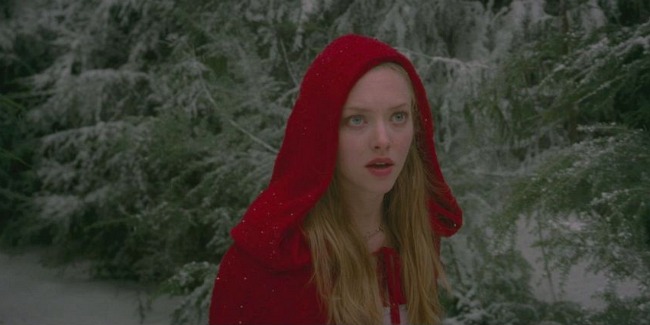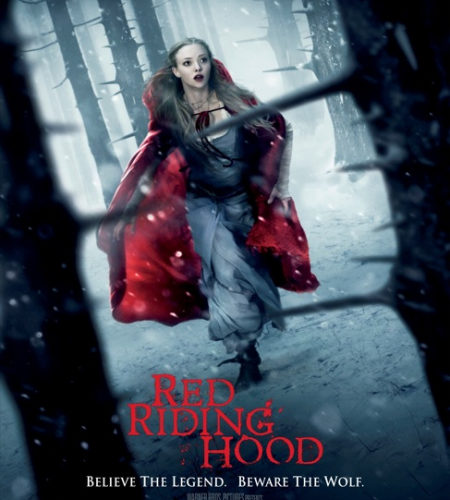
The point of a fairy tale is to scare the bejesus out of little kids until they learn a lesson. Or, at the very least, make them think twice about involving themselves in potentially dangerous situations. “Little Red Riding Hood,” most notably credited to those lovable scamps The Brothers Grimm, tells of a young girl who strikes out alone into the woods to meet her grandmother. Along the way, she meets a wolf who tricks her into revealing the nature and destination of her journey. The wolf enjoys a free lunch, so he ends up swallowing whole both the girl’s grandmother and Little Red herself. A timely nearby hunter saves them both, but the audience walks away with two lessons: don’t talk to strangers and don’t go out into the world alone, because hunters with giant knives might not always be around to save you.
Sure, this is a pretty ridiculous story on many fronts. Wolves can’t talk, let alone be conniving enough to trick a child or have the acting chops to trick said child into thinking he’s actually her grandmother. Beyond that, once you’re eaten by a creature, you can’t be plucked out safely in one piece; surely there must be some stomach acid to deal with. But no matter. The details are to scare, the point is to impart a practical life lesson lesson.
Red Riding Hood, the new film by Twilight director Catherine Hardwicke, involves the cape and the ludicrous details of the old story, but suffers mightily in trying to make a cohesive point.
The film stars Amanda Seyfried as Valerie (she’s never once referred to by her cloak, sadly). She lives off in a village near the woods that looks like a condo developer got a hold of some Lincoln Logs and felt like making something “rustic.” You see, there’s a wolf that lives out in those dark woods near the village and come each full moon he feeds upon a helping of whatever cute, tiny livestock the villagers have laying around that they can sacrifice (one assumes it likes bacon more than human flesh). One night, however, the wolf forgoes eating a piglet and goes after Valerie’s sister, much to the dismay of Suzette (Virginia Madsen), the girls’ stoic mother, and Cesaire (Billy Burke), their aimless drunk of a father.
To add to this tragedy, Valerie is betrothed to Max Iron‘s Henry, a man she does not love even though he apparently has a great fortune (regardless of the fact that everyone dresses the same and live in nearly identical log cabins). Valerie has love only for one boy, Peter, played by Shiloh Fernandez wearing Edward Cullen’s hair, a local lumberjack who specializes in brooding in all-black cloaks. Peter and Valerie have known each other since they were kids, running off to the woods together and lusting after one another in a love story that could never be because the plot does not allow it to.
 From the onset, this film moves, much to the detriment of the film itself. The narrative locomotion barely stops for anything, be it a pause to mourn the loss of loved ones, a time for the characters to contemplate their actions, or a respite of logic. Much like the film’s furry antagonist, Red Riding Hood constantly chugs forward. Within the first twenty or so minutes, the following themes are broached: fear, how people’s characters can change under such conditions, what true love is, the importance of monetary security, how to not treat people who are different from you, and the mixing of revenge and blood lust are all broached.
From the onset, this film moves, much to the detriment of the film itself. The narrative locomotion barely stops for anything, be it a pause to mourn the loss of loved ones, a time for the characters to contemplate their actions, or a respite of logic. Much like the film’s furry antagonist, Red Riding Hood constantly chugs forward. Within the first twenty or so minutes, the following themes are broached: fear, how people’s characters can change under such conditions, what true love is, the importance of monetary security, how to not treat people who are different from you, and the mixing of revenge and blood lust are all broached.
Then Father Auguste (Gary Oldman), a priest who has had some personal experiences with werewolves in the past, arrives with a bunch of stuntmen from 300 and a large metal elephant, turning this village into his personally-run police state. Yes, you read that properly. So now, on top of the themes already mentioned, we heap on top if it how to view trust (both with governmental powers and within our personal lives), the dangers of using religion as a weapon, how doing things “by the book” could lead to moral dilemmas, how we can lose prospective of our morals in chaos, and so on and so forth. By the way, this all occurs before our little rider even gets her red hood, a wedding gift from her grandmother (Julie Christie) who does live out in the woods for no other logical reason given outside of the original story itself.
Much like the original fairytale, the film deals with arch caricatures running around like senseless children. Unfortunately, the narrative is as nonsensical and inorganic as the oddly-spiked trees that populate the area surrounding grandma’s cabin. It’s a film that mixes the convenience of an action film (why can’t any of these specialists shoot their guns straight?) with the forbidden love story of many The Notebook-styled films, all the while shrouded in the supernatural specter of a teen paranormal romance novel (which takes up five rows of shelf space in my local Barnes & Noble).
It’s not difficult to see why this film was made, but there’s no reason why it should be this confusing and, somehow, still end up so bland. By the end of the journey, the identity of the wolf is revealed and I’ll be shocked if you happen to give a damn. You’ll be far too busy trying to figure out what is the point of it all.

